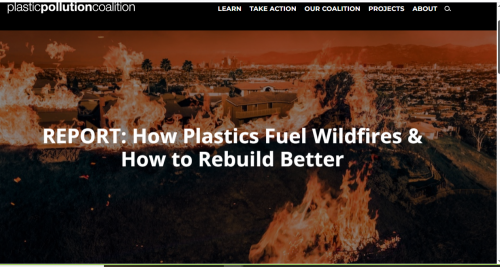
https://www.plasticpollutioncoalition.org/report-plastics-fuel-wildfires...
The report, titled, “How Plastics Fuel Wildfires & How to Rebuild Better,” is intended to inform those in the architecture, building, design, engineering, and policy spaces about the links between plastics and wildfires, and how communities at risk of and/or affected by wildfires build and rebuild better with safer, plastic-free materials. The report presents key findings about the links between plastics and wildfires, focusing on the case study of the January 2025 wildfires that burned through Los Angeles, California—an example of our increasingly plastic cities.
Key findings of the report include:
-
Buildings made of and furnished by plastics are more flammable than those made of traditional materials like metal, stone, and wood, and are more more dangerous for firefighters to attempt to extinguish
-
When wildfires burn through densely built-up urban and suburban areas, large amounts of plastics are open-burned, releasing some of the most toxic chemicals into already dangerous wildfire smoke, like dioxins and phthalates, in addition to hazardous microplastics
-
Wildfires and plastic pollution contaminate drinking water in compounding ways, with toxic runoff, chemical leaching from heated plastic pipes, and widespread damage to water systems; more than 100 toxic chemicals have been found in contaminated drinking water after wildfires
-
Wildfire ash and chemical residues can persist in the environment long after fires and smoke have cleared, and high winds, rain, and other weather events can re-expose individuals in areas affected by fire to pollutants for years or even decades
The report presents readily available healthier and more sustainable alternatives to plastic building materials, often with comparable cost and performance. It spotlights Habitable’s Informed™, a free, publicly available product guidance grounded in science based research, using a red-to-green ranking that allows building industry practitioners to easily avoid worst-in-class products that are ranked red, and prefer those ranked yellow or green that tend to be no or low-plastic.
“The toxic pollution from the climate-change fueled wildfires that erupted in Los Angeles in January 2025 is a tragic example of what happens when our highly plasticized built environment burns. Plastics not only make wildfires worse, their production also fuels climate change, compounding the risks. We must urgently eliminate plastics from our built environment, and build and rebuild better with nontoxic and plastic-free alternatives.” — Dianna Cohen, Co-Founder and CEO, Plastic Pollution Coalition
“Plastics burn hot, fast, and toxic. They are now ubiquitous in our buildings. Fortunately, many natural, healthier materials already exist and should be prioritized—not only in wildfire-prone areas, but in all buildings—as a way to reduce fire risks and their toxic aftermath.” — Gina Ciganik, CEO, Habitable
PRESS CONTACTS:
Plastic Pollution Coalition
Press@plasticpollutioncoalition.org
+1(323) 936-3010 x1
Habitable
media@habitablefuture.org









